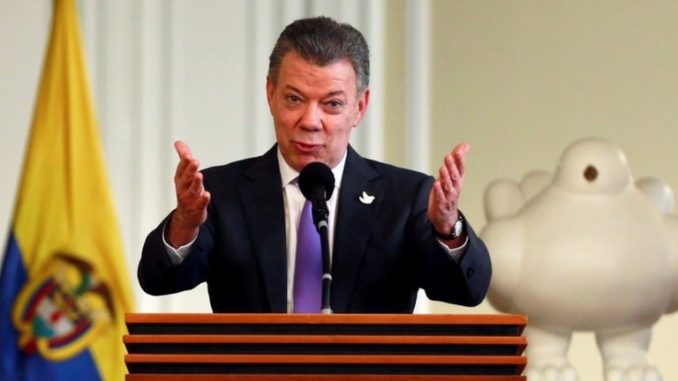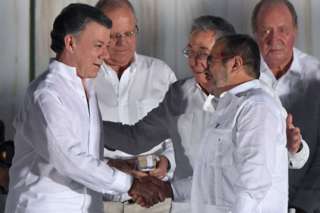
Colombia’s President Santos donates Nobel money to conflict victims
-
9 October 2016
- From the section Latin America & Caribbean
 Image copyright
Image copyright
AFP
President Santos (left) and the Farc leader known as Timochenko shook hands in a historic ceremony in Cartagena in September
Colombian President Juan Manuel Santos has said he will donate the money from the Nobel Peace prize to help the victims of the 52-year conflict in his country.
He was awarded the prize for reaching a peace agreement with the Farc rebel group last month.
The deal was rejected a few days later by Colombian voters in a referendum.
About 260,000 people have been killed and more than six million internally displaced in Colombia.
“Last night, I met with my family and we have decided to donate those eight million Swedish krona ($925,000) to the victims,” said Mr Santos.
- Who are the Farc?
- Colombia media hopeful over Santos peace prize
- Viewpoint: What next for Colombia?
- Santos: From hawk to dove
He made the announcement in the city of Bojaya, in the north-western region of Choco, after taking part religious ceremony for people affected by the conflict.
The head of the Nobel commitee said on Friday the award recognised the president’s “resolute efforts” to end the conflict.
Image copyright
AFP
Victims of the 1994 La Chinita massacre took part in a recent reconciliation meeting with the Farc
“The award should also be seen as a tribute to the Colombian people who, despite great hardships and abuses, have not given up hope of a just peace, and to all the parties who have contributed to the peace process,” Kaci Kullman Five added.
Mr Santos said he dedicated the award to “all the victims of the conflict”.
The award did not include the Farc (Revolutionary Armed Forces of Colombia) leader Timoleon Rodriguez, better known as Timochenko.
He also signed the accord after nearly four years of negotiations held by government and rebel delegates in the Cuban capital, Havana.
Juan Manuel Santos
Image copyright
EPA
- Born in Bogota in 10 August 1951 in an influential family
- Elected Colombian president in 2010 and re-elected in 2014
- Served as defence minister from 2006 until 2009
- Married, has two sons and one daughter
Sources: BBC Monitoring, Colombian presidency
The peace deal was rejected by 50.2% of voters who went to the polls on 2 October.
The committee acknowledged the result, saying: “What the ‘No’ side rejected was not the desire for peace, but a specific peace agreement.”
It also said that finding a balance between the need for reconciliation and ensuring justice for the victims would be a difficult challenge.
Despite the rejection by voters, Mr Santos vowed to continue with talks with the rebels.
Government negotiators have already returned to the Cuban capital Havana for further discussions with Farc leaders.
On Twitter, Farc leader Timochenko said: “I congratulate President Juan Manuel Santos, Cuba and Norway, who sponsored the process, and Venezuela and Chile, who assisted it, without them, peace would be impossible.”
Critics, led by former President Alvaro Uribe, said the deal was too lenient on the rebels.
The Farc’s 52-year fight
Image copyright
Reuters
1964: Set up as armed wing of Communist Party
2002: At its height, it had an army of 20,000 fighters controlling up to a third of the country. Senator Ingrid Betancourt was kidnapped and held for six years along with 14 other hostages
2008: The Farc suffers a series of defeats in its worst year
2012: Start of peace talks in Havana
2016: Definitive ceasefire
Under the agreement, special courts would have been created to try crimes committed during the conflict.
Those who confessed would have received lighter sentences and avoided serving any time in conventional prisons.
The Farc would also have been guaranteed 10 seats in the Colombian Congress in the 2018 and 2022 elections.
